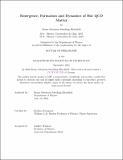Emergence, Formation and Dynamics of Hot QCD Matter
Author(s)
Scheihing Hitschfeld, Bruno Sebastian
DownloadThesis PDF (11.49Mb)
Advisor
Rajagopal, Krishna
Terms of use
Metadata
Show full item recordAbstract
Understanding the dynamics of Quantum Chromodynamics (QCD) in quantitative detail is one of the main frontiers in particle physics. While the last century gave us the formulation of the theory of nuclear interactions, QCD, as well as that of the rest of visible matter encoded in the Standard Model of Particle Physics, much remains to be understood. In particular, the hot QCD matter produced in high energy collisions of heavy ions presents a unique challenge to theory and phenomenology due to the vast number of different phenomena that take place in such a collision, and even more so because it is an out-of-equilibrium process. In this thesis, we make progress in two concrete directions in the vast landscape of hot QCD physics. The first one is quarkonium transport inside quark-gluon plasma (QGP), the high temperature phase of QCD. Over the past two decades it has been realized that a significant fraction of quarkonium suppression in high energy heavy ion collisions comes from dynamic dissociation and recombination processes, instead of static screening of the interaction potential as originally proposed by Matsui and Satz. Our contribution is the formulation of the precise correlation functions in QCD at finite temperature that describe the dissociation and recombination processes of heavy quarkonium in QGP, as well as their calculation in weakly coupled QCD and strongly coupled N=4 supersymmetric Yang-Mills theory. We also formulate the Euclidean version of these correlation functions so that they may be calculated using Lattice QCD techniques. In this way, our results provide the necessary ingredients to carry out an analysis of the suppression of ϒ states in heavy ion collisions in terms of the parameters of the QCD lagrangian.
The second contribution we make is the development of tools to understand the process of hydrodynamization in QCD kinetic theory and their application to a simplified description where only a subset of the QCD scattering mechanisms are included. By doing this, we learn that the process of hydrodynamization in this theory, and specifically, how memory of the initial condition is lost, follows the recently proposed Adiabatic Hydrodynamization scenario.
Concretely, hydrodynamization proceeds through a sequential process in which a monotonously shrinking set of low-energy states dominate the dynamics, where the opening of an energy gap relative to the ground state(s) signals the start of each stage of this process. The hydrodynamic attractor is reached when only one low-energy state remains as the ground state, and the system approaches local thermal equilibrium following the adiabatic evolution of this low-energy state.
Date issued
2024-09Department
Massachusetts Institute of Technology. Department of PhysicsPublisher
Massachusetts Institute of Technology